The Tools - Book Review
Contents
This blogpost summarizes a few ideas from the book titled “The Tools”, by Phil Stutz and Barry Michels

Revelation of a New Way
The authors of the book, Dr. Phil Stutz and Dr. Barry Michels, create an appealing and a powerful introduction to the book, making the reader curious about “tools”. How did they come up with these tools ? The story goes that Dr. Barry was frustrated by the theoretical and academic solutions for solving his patients problems. All his patients were looking for something to be done concretely, while all he could offer was some vague recommendation that was devoid of certain specific action. Most of the skills taught in the standard curriculum involved exploring “depth”, i.e. revisit childhood, revisiting dark areas of one’s lives and listening to the patient. While the patient was looking for concrete solutions, all he could offer was a listening ear. This was frustrating for him as he was expected to let patients figure out a solution in their therapy session. His curiosity lead him to Dr. Phil Stutz seminar, an event where Barry found a powerful way to work to deal with his patients problems. These tools seem to work and the fact that patients were reporting actual improvement in their lives was a testimony to the efficacy.
Dr.Phil Stutz, himself a psycho-therapist did not conjure up these tools on a rainy day. These tools were a result of his own obsession with offering something concrete and effective to his patients. In his line of work, he figured out that the mere attitudinal changes are not enough. Life requires behavioral change and this is not the same as attitudinal change that is more intellectual in nature. It soon dawned on him that the tools that his patients were using, made them not only return to their normal behavior but they had started to become powerful, confident and effective in their lives. That’s when the author realizes that these tools have the power to access hidden higher forces that might turn a hitherto “problematic” patient in to being a joyous and successful individual.
The main content of the book is introducing the reader the four tools that can be used in various circumstances in our lives. There is also an addition tool called “Jeopardy”, that is more a meta-tool that helps us in making sure we keep using the four tools described in the book.
Tool 1 - The Reversal of Desire
The chapter talks about meeting our fears head on. The message is not something new. We have heard it in any number of motivational talks, books, podcasts. What’s different about the author’s message ? There is a massive difference between the way one comes across this clichéd phrase and the way authors present it. There is a higher force that wants us radiate our inner energy in to the world. There is a higher force that the authors call “The Force of Forward Motion”. With that premise in place, the following visual helps us understand the situation we find ourselves and the way to get out of this situation.
Avoiding pain wouldn’t be a problem if we did it once or twice a year. But for most of us, it’s a deeply ingrained habit. We barricade ourselves behind an invisible wall and don’t venture out because beyond the wall is pain. This safe space is called the “Comfort Zone.” In the most extreme cases, people hide behind the actual walls of their home, afraid to venture into the outside world. That’s what it means to be agoraphobic. But for most of us, the Comfort Zone isn’t a physical place; it’s a way of life that avoids anything that might be painful.
The Comfort Zone is supposed to keep your life safe, but what it really does is keep your life small.
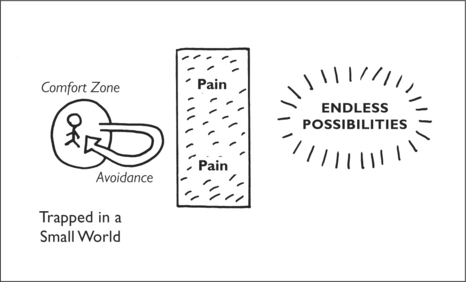
Most of us are like the stick figure, stuck inside the Comfort Zone. To take advantage of the endless possibilities that life provides us, we have to venture out. The first thing we meet is pain. Without a way to get through it, we scurry back to safety. This is depicted in the arrow that goes out, comes close to pain, and turns back again. Eventually, we give up on ever escaping the Comfort Zone; our most treasured dreams and aspirations are lost. Nineteenth-century physician, teacher, and author Oliver Wendell Holmes in “The Voiceless” wrote: “Alas for those that never sing, / But die with all their music in them.”

Using the tool regularly reveals the secret about pain that allows you to master it: pain is not absolute. Your experience of pain changes relative to how you react to it. When you move toward it, pain shrinks. When you move away from it, pain grows. If you flee from it, pain pursues you like a monster in a dream. If you confront the monster, it goes away. That’s why desire is a crucial part of the tool. It keeps you moving toward pain. You’re not desiring pain because you’re masochistic; you’re desiring pain so you can shrink it. When you become confident you can do this every time, you’ve mastered your fear of pain. The diagram how this process works. This time, when the figure leaves the Comfort Zone, he has a completely different mind-set. Not only isn’t he trying to avoid pain, he desires it. It’s this desire that puts him in motion; as I’ve said, when you’re moving toward it, pain shrinks and becomes less intimidating. You can now move through it into an expanded world of endless possibility.
In a sense, the message here is NOT that - pain is OK, endure it and you will become better person. Instead we need to actively seek out pain as that is the way to shrink it and realize endless possibilities. We intuitively know this. If we reflect back on our lives, the most pleasurable moments our lives have always preceded with actions that involved us tackling pain, whether we actively sought it in the first place or it was thrust-ed upon us. Loving pain is not masochistic but it means that you need to be in unison with pain. That is the only way to get through it and shrink its effect.
The authors show a one to one mapping between the tool and one of the higher forces. Reversal of desire is a tool to access “Force of Forward Motion”
Everything that’s alive is evolving into the future with a sense of purpose—from a single organism to a species to the entire planet. Dylan Thomas called it “The force that through the green fuse drives the flower.” The continuous existence of life over millions of years is a testament to the invincible strength of the Force of Forward Motion.
Higher forces does not mean spiritual. It comes from something beyond your ego. It does not really matter what you call it. Every one has experienced it at some point in time. The more they are connected to higher forces, the more they realize their potential.
When does one get to use this tool ?
- In any situation that makes you afraid of leaving the known comfort zone
- In any situation that warrants action where we instead think about it, stalling the action because we imagine the pain that will bring to us
What does one exactly do ?
Focus on the pain you’re avoiding; see it appear in front of you as a cloud. Silently scream, “Bring it on!” to demand the pain; you want it because it has great value.
Scream silently, “I love pain!” as you keep moving forward. Move so deeply into the pain you’re at one with it.
Feel the cloud spit you out and close behind you. Say inwardly, “Pain sets me free!” As you leave the cloud, feel yourself propelled forward into a realm of pure light.
Takeaway
Unconsciously there have been many areas that I have been avoiding pain. The first area is the way I have been playing Sitar. I have not made any attempt to practice Gamaks or Meend. It is rather frustrating to actually sit with an instrument and try to pull the strings to create sounds when the same sound can be produced by placing finger on the fret. Instead of trying to master the art of playing the notes G, M and P from the fret that is used to play R, I have always taken the easy route of placing my fingers on the respective frets G, M, P to play. I have heard a million times from various teachers that playing Meend is what makes playing Sitar beautiful. However I have never addressed the pain associated with it directly. I have always been taking the easy way out and in the process always staying in my comfort zone, trying to be more analytic while composing taans and thihayees. Analytic bent of mind is the comfort zone I have been in. One fallout of reading this book is that I am going to practice Gamak and Meend, starting today and see where it takes me. Intuitively, I had always wanted but reading this tool makes me motivated to play gamaks starting today.
The other comfort zone that I have been in, is in my professional life. I have become reasonably skillful in delivering stuff at work. However deep in my heart, I know that I don’t really get energized by the current line of work. It is high time I face the pain head on and start working on ways to move on a path that I has unconsciously desired for more than a decade.
Tool 2 - Active Love
There are many situations in our lives where we get caught up in our own thinking and it is usually recursive. The trigger can be anything - a remark from your colleague/boss/friend, a behaviour from any of your family members, an indulgence that you cannot satisfy for some reason, an undesirable outcome such as losing a match/ losing a trade / losing a deal. We enter in to a maze of thinking that hijacks our mind from performing optimally. Also the trigger can be anything from the past or something we are imagining in the future. Most of us realize that we have entered in to a maze but we don’t seem to know of a way to get out of it. It has happened to me in many situations and the result is that I lose many precious hours in the state.
When you are in the maze, life passes you by.
Why are we trapped in a Maze ? Well, we it is all flowing from our premise that world should treat us fairly. The trick to getting out of the Maze is to generate a form of love that’s independent of your immediate reactions.
The tool mentioned in this chapter is connected to the higher force called “Outflow”.
Outflow is an infinite, spiritual force that gives of itself without restraint. It’s like sunlight, shining equally on everything and everyone. The moment you feel this force, you’re lifted above your petty hurt feelings. You no longer need a remedy from the offending person because Outflow is its own reward.
The tool mentioned in this chapter has three steps:
The first step is called “concentration.” You’re gathering up all the love that surrounds you and concentrating it in your heart—which is the only organ that can find it and hold it.
The second step is called “transmission.” In this step your heart functions as a conduit, transmitting love from a higher place into this world.
The real power of the tool is in the third step, which is called “penetration.” When you feel the love you’re transmitting enter the other person, there’s a sense of total acceptance; an acceptance that comes only with the experience of oneness. This is a victory—you’ve embraced injustice completely and are free to move on from it. With this new power, no one has the power to put you in the Maze. No one can stop you.
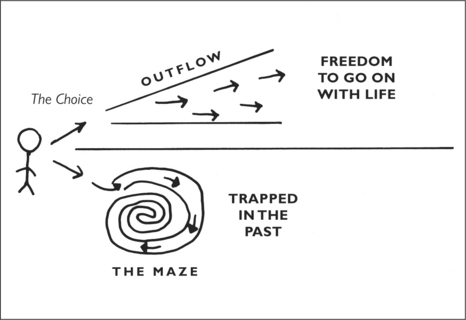
The stick figure is you, the moment after you’ve experienced an injustice. The lower arrow indicates that you do nothing; in effect, you’ve chosen to enter the Maze. The upper arrow indicates that you’ve chosen to put yourself through the three steps of Active Love. This decision unites you with Outflow; you’re free to move into the future. Many patients visualize this picture when injured to remind themselves they do have a choice.
The cues mentioned for this tool are
- when someone does something to you that makes you angry
- when you are reacting to the memory of something done to you weeks or years ago
- preparing yourself to deal with difficult people.
The authors give examples to show that Active Love build self-control, lets you be more assertive and trains you to accept others as they are.
Takeaway
At the outset, I am skeptical of this tool. But I will try to keep an open mind and practice using this tool. There are definitely situations in which I experience anger, resentment, frustration at home because others are not behaving the way I want to behave(how immature that is). There have also been situations in the recent months where I have entered in to this maze of crappy thinking that I found it difficult to get out of it. May be I will start using this tool and figure out whether this behavior does help me in some way.
Tool 3 - Inner Authority
One of the fastest way to destroy your potential is to turn against yourself. All those feelings and thoughts that show your in a bad light has an effect on self-expression.
The authors talk about “Shadow”, a separate self that is living inside you. The “Shadow” is everything we don’t want to be but fear we are, represented in a single image. It’s called the Shadow because it follows us wherever we go. The Shadow is the source of one of the most basic human conflicts. Everyone wants to feel that as an individual we are valuable. But when we look inside ourselves, we see the Shadow and we’re ashamed. Our immediate reaction is to turn away- to look outside ourselves for some evidence of our worth. This takes the form of external validation. The problem is, no amount of approval from others can make you feel worthy - because no amount of validation can eliminate your Shadow.
Your shadow has borne all the negative criticism. Since you have always showered negativity on “Shadow”, your self-expression is never genuine. You are forever thinking about what others think of you.
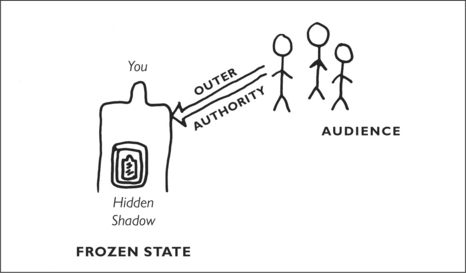
The picture diagrams the state of affairs in someone prone to freezing (which is almost everyone). The person is ashamed of his Shadow and does everything possible to keep it hidden inside him. This is illustrated by the box around the shaded figure labeled “Hidden Shadow.” The audience figures in the upper right are big because the person experiences them as having the power to define his value. This power comes at him through the arrows labeled “Outer Authority.” Since he’s hiding his Shadow, the external force causes him to freeze.
As the picture makes clear, looking outward doesn’t work any better than looking inward; either way, a real sense of self-worth tends to elude us.
There is a way to find it; it involves a profound secret. What appears to be a weak and inferior Shadow is really the conduit for a higher force—and it’s only this higher force that can give us enduring self-worth.
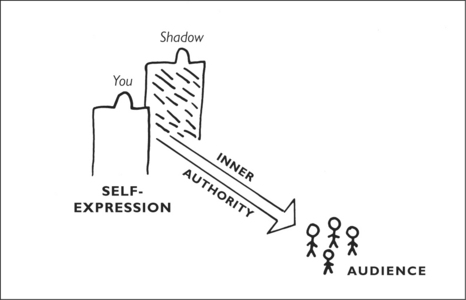
The person in the picture has brought the Shadow out of hiding. It’s now outside the person and bonded with him. Speaking with one voice, they evoke the Force of Self-Expression. This higher force gives the person inner authority, indicated by the arrow moving out toward the audience. The figures representing the audience are small and below the person—they’re no longer a threat.
The expressive power of the inner self is released through this bond with the Shadow. Once you become an advanced practitioner of the tool, you’ll be able to express yourself freely in situations that you would’ve frozen in previously.
The best way to connect with your shadow is to imagine standing in front of your audience that is critical about you. Put your consciousness in the audience. They are seeing all your insecurities. You are looking through the eyes of this hypercritical audience. You will see a version of yourself that is over flawed. Whatever you are saying is “Shadow”
How do you bond with your Shadow ? The trick is to look at your life from Shadow’s point of view. It has not been good living inside you. You have constantly put him down. You have constantly hidden him. It is in constant rejection and humiliation. If you know what it feels to be reviled unfairly, you know how the shadow feels towards you. Once you start empathize with the Shadow, then it starts bonding with you.
The tool has three steps:
- See the Shadow
- Bond with the Shadow
- Turn towards audience and command the audience to LISTEN
Imagine that you’re standing in front of an audience of one or many. See an image of your Shadow off to one side, facing you. Ignore the audience completely and focus all of your attention on the Shadow. Feel an unbreakable bond between the two of you—as a unit you’re fearless.
Together, you and the Shadow forcefully turn toward the audience and silently command them to “LISTEN!” Feel the authority that comes when you and your Shadow speak with one voice.
Takeaway
Well, there is a nasty ugly version inside me. It is definitely something I despise. Unlike seeking external validation, I have always tried to forget the internal and external world. I have been living in this bubble that I have made up for myself where I think I should be immune to external validation. At the same time, I do not even think of this “Shadow”.
In one sense, I have not acknowledged my Shadow’s presence for many years. I guess I was always afraid that my inner Shadow was so mean and far removed from a version of what I wanted to be. Hence I had banished my Shadow out of my conscious mind. It is ironical that I attribute all the negative aspects to this “Shadow”. May be it is time I start working with my Shadow. May be, I have lived all my life superficially as the authors suggest of any person who divorces from his/her “Shadow”. Turning to that inner “Shadow” and befriending it does look like an uphill task especially when there are certainly evil and nasty traits that I have implicitly attributed to it.
Tool 4 - The Grateful Flow
The authors talk about “Black cloud” that most of us carry on our heads, that obstructs us from experiencing the higher powers. The components of the “Black Cloud” could be all those emotions that keep us from experiencing an energized and peaceful life. Think of all the times you worried about past, present or future. Think of all the insecurities, fears, toxic indulgences and they are in some form or the other the components of the black cloud
The authors use the following visuals to drive home the importance of expressing gratitude:
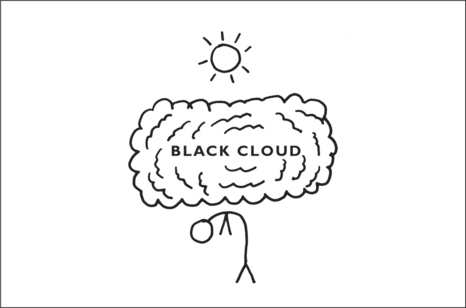
Above the cloud is the sun, the universal symbol for the positive. Here, it would represent all that is right in the world. We’ve drawn the Black Cloud as an impenetrable shroud that keeps out the positive. The sun is still shining, but for the person under the cloud, it doesn’t exist. There is no joy; only negativity. He’s bent over by the heaviness of the dark world his thoughts have created. There’s a huge price to pay for living this way.
For the person crushed by the Black Cloud, there can be no peace of mind.
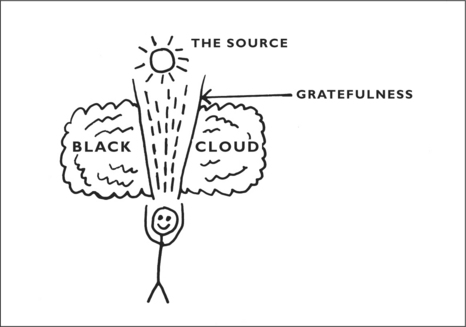
It creates a sense of gratefulness that’s so powerful it penetrates the Black Cloud. This is illustrated by the channel that extends upward from the person, splitting the Cloud. The small lines inside the channel represent the force of gratefulness, flowing upward. In the earlier drawing , the sun shining above the Cloud represented whatever was right with the world. Now we can give the sun its proper name: the Source, the creator of all that is, the ultimate positive force in the universe. This picture shows how gratefulness becomes an organ that connects us to the Source.
There are two assumptions that we can have about our life and world in general - One is that universe does not care about us. It is chugging along in a path where we are bystanders. Another assumption we can make is, universe is interested in our welfare, supporting us in ways large and small. The authors give a hack that can enable us to verify the assumption that we might be making - By expressing gratitude towards one and all.
This is something that I have tried in my life many years ago. I have tried to make it a part of daily ritual by expressing a silent thanks to a few people in my life. The authors though, give a far more powerful reason that should motivate anyone to use this tool. This tool will help one connect to a far bigger energy source that one can imagine and prepare us to take risks.
Tool 5 - Jeopardy
The authors make a point that the all the tools introduced in the previous chapters are not “use once and forget as soon as you hit a sweet spot in your life”. The authors use the story of Vinny, from one of the earlier chapters, who loses everything once he stops using the tools. Every one of us has a fantasy of a “magical something” - a relationship, a job, an achievement, or possession - that will remove us from the treadmill. It’s the fantasy that we’d stop needing higher forces to complete ourselves.
Events are temporary. You need to find a permanent source of jeopardy. There’s only one thing you’re at risk of losing every moment. Its your future. Most people don’t think of the future as something that’s theirs to lose. Not only does this enable you to overcome your problems in the present, it changes who you become in the future. Whether you’re a novelist, an entrepreneur, or a parent, you become capable in a way you never were before. You become a party to the shaping of your own future. with access to higher forces, your potential has no limits.
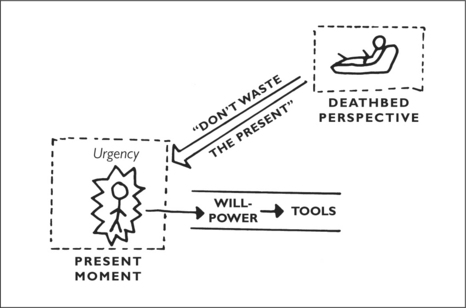
The figure at the upper right represents you lying on your deathbed. He’s much more aware than you are that time is limited. His warning to you is symbolized by the arrow labeled, “Don’t waste the present.” The figure inside the box labeled “Present Moment” is you. The jagged lines surrounding you represent urgent pressure to use the present moment before it’s gone. It’s this urgency that creates the willpower to use the tools. As long as you remain aware of this warning, you’ll have the will to use the tools over and over again. You’re shaping a pathway to an expanded future.
In one sense, this chapter’s message is that by constantly thinking about death, we are able to summon willpower needed to use the tools regularly in our life. In whatever situation you may be in, a periodic pause to imagine your death bed state is a great way to bring clarity to the situation. All your thoughts such as insecurity, anger, temptations might pale in comparison to what you might want to actually remember doing, in a future death bed state.
The Faith in Higher Forces
The chapter talks about authors struggle to come to terms with “higher forces”. Barry Michels was raised by atheist parents and the family had no place for the word “faith”. A few events in his life start making him feel that there is some cosmic intelligence that is driving his life. He starts questioning the whole notion that we ought to think rationally and not believe in some unknown forces. Just then Phil Stutz gives him an index card and says
Participate in the system and experience what he called “higher forces”
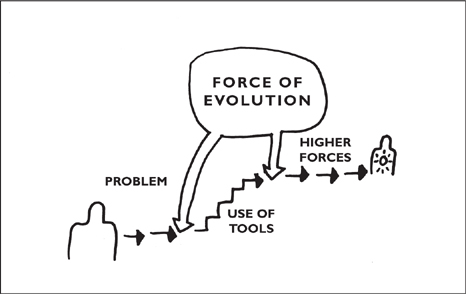
The figure on the left is faced with a life problem; it might be an illness, a job loss, or even the inner confusion I was going through. As the first thick arrow indicates, the problem is sent down by the force that governs evolution (which you can call God, Higher Power, etc.). Then the person uses tools to resolve the problem, illustrated by the steps. They lead upward to an expanded level of existence where he has access to higher forces, allowing him to do things he’s never done before. This reveals the hidden purpose of the entire spiritual system: to enable us to become creators. In the picture, creatorship is represented by the sun inside the figure on the far right. The drawing reveals an amazing secret: both the problem and the higher forces that solve it come from the same source—the Force of Evolution. These two elements are part of one system, designed to transform you into a creator. But there’s a third ingredient, and it’s one the universe cannot supply. That ingredient is your free will; specifically, your will to use tools. The choice—evolve or stay the same—is yours.
Barry worked inside the system and applied it to a real life problem and use the tools. By fixating on the index card and carrying a mindset of actually working with the tooks, Barry finally began to experience higher forces.
Phil Stutz’s story of stumbling on to “hidden forces” highlights the point that it is only by entering in to our inner world can we find the “hidden forces”. No amount of external fixes can help us experience the “hidden forces”.
The Fruits of New Vision
The chapter talk about three pillars of new spirituality
-
Thinking about higher forces is worthless, you have to experience them
-
When it comes to spiritual reality, each of us is his own authority
-
Personal problems drive the evolution of the individual
This chapter was towards the end of the book and I found that I was so eager to use some of the tools that I could not really digest the content in this chapter. May be I will revisit at a later date.
Audio and Video content
After doing a random Internet search , I realized that there are many good podcasts that go in to the details of these tools. I have managed to go through these audio/video material to get a better understanding of the tools:
- Optimize Podcast - Part 1
- Optimize Podcast - Part 2
- Optimize Podcast - Part 3
- Talk at Google
- “Stutz”, a Netflix documentary released in Nov 2022 that goes in to some of the tools mentioned in the book.
Here are some additional points from some of the audio/video content:
- Our minds have been inundated with images that form a black cloud
- People do not want to change their habits even though they seem harmful
- Let’s say you use the tool and it starts to work. That accomplishment will be conveyed to other family members. It is better not to verbalize these tools to your family members and instead allow them to notice the changes themselves.
- Express gratitude towards a few aspects in life. Once you have done that, you want to remain aware of the force of thoughts. It is a force that lets you be grateful.
- Leverage your problems in to potential
- Active Love is designed to address a state of mind called “Maze”
- Outflow loves life in all of its forms. It completely accepts everything that happens. It is something like sunlight. It is the force that really embodies everything.
- A tool that can change your inner state immediately. It is a real time visualization exercise you do at certain moments in life
- Power of cards is that they turn big ideas in to simple ways to remember them and use them
- Stutz is now having Parkinson’s disease. Amazing at what a person suffering such a painful affliction can speak cogently and spread his ideas
- A possibility means that you feel yourself acting differently
- You can always work on your life force. It is only part of way that drives you when you are lost
- You have relationship with physical body, other people, and yourself. Think of
it as a pyramid
- Body is what you do with with it - exercise, diet, what you eat, how you treat it ?
- Relationships are handholds that get you back to your life
- Write something every day. Things will come out when you start writing a journal. You will find out about something that you didn’t know that that existed with in you
- Part X is a part of understanding how tools work
- Anti social part of you
- Wants to block your potential
- It is a Lillian in the story. It is the voice of impossibility.
- People cannot get rid of Part X
- Three aspects of reality that no one gets to avoid
- Pain
- Uncertainty
- Constant Work
- If you banish Part X, then there is no story
- What will make you happy is to learn the process of dealing the three aspects
of reality. You have to learn the process of loving these three things
- You can identify these things in life and use a tool
- Highest creative expression for a human being is to be able to create something new right in the face of adversity. The worse the adversity, the greater the opportunity
- The shame and embarrassment is what ties all of us together
- String of pearls - each pearl is an action. Every action has the same value. I am the person who puts a pearl on the string
- True confidence is living in uncertainty
- Winner is the one who is willing to take a risk
- Every pearl is a turd. Forget about getting the perfect pearl.
- Every body has a shadow. In a way it is same. It is what someone is ashamed of
- Talk to Shadow and see what Shadow feels about the way you treat ?
- Shadow needs your attention.
- Goal of “Inner Authority” tool is to true to your inner shadow. It is process of constantly relating to the Shadow
- Snapshot
- Realm of illusion
- You are looking for a perfect experience (perfect money, perfect friend, perfect partner, etc)
- You have taken a snapshot that has no context.
- The Maze always involves other people. The quest for fairness puts you on
hold. Time is fleeting and we don’t have time on that bullshit
- The average person wants things to be fair. You are not going to get from external world. You get it from “Active Love”.
- Radical Acceptance - Find something meaningful out of everything
- Part X wants you to feel negative. With gratefulness, you can see pierce through the cloud
- Gratefulness is the state that you want to be in most of the time. Part X tries you to get out of the state.
- Loss processing
- I am willing to lose everything
- You are moving towards non-attachment when you have a loss
- Happiness depends on acceptance
Takeaway
The moment I picked up the book, I could not put the book down until I read it till the end. There are many aspects that any rational person would scoff at, such as the visualization exercises, cues and the various ideas mentioned in the book. But I think if one keeps one’s skepticism aside, the tools might just be super powerful in bringing out a behavioral change. The tools accompanied by visuals makes them easy to stick for the reader. Complicated ideas around human psychology are explained in the book and might make it an interesting read. Do I want to revisit these ideas at a later point in time ? Absolutely. Is the book for everyone ? It might not be appealing for someone who doesn’t want to believe in a higher forces that underpin all the tools mentioned in the book. But for someone who is willing to try to experiment and try out the tools, the book might be a life changing one.